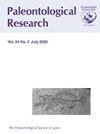Nonmarine Mass Extinctions
IF 0.6
4区 地球科学
Q3 PALEONTOLOGY
引用次数: 12
Abstract
Abstract. A critical review of putative nonmarine mass extinctions associated with the so-called “Big 5 mass extinctions” of marine invertebrates (Late Ordovician, Late Devonian, end Permian, end Triassic and end Cretaceous) as well as a likely sixth mass extinction in the marine realm, the end-Guadalupian extinction, reveals little evidence of coeval marine and nonmarine mass extinctions. Little lived on land during the Ordovician other than a bryophyte-like flora that appears to have been diversifying, not going extinct, during the Late Ordovician. No case can be made for mass extinctions on land coeval with the marine extinctions of the Late Devonian-land plant diversity increased into the Carboniferous, and the tetrapod fossil record is inadequate to identify any mass extinctions. A case can be made for coeval plant/tetrapod extinctions and the end-Guadalupian marine extinctions, so this may be the first coeval marine-nonmarine mass extinction. However, problems of timing and questions about the extent of the nonmarine late/end-Guadalupian extinctions indicate that further research is needed. There were no mass extinctions of land plants, insects or tetrapods across the Permo–Triassic boundary. The Late Triassic was a time of low origination and high extinction rates on land and in the seas; there was no single end-Triassic mass extinction in either realm. The end-Cretaceous provides the strongest case for coeval land–sea mass extinctions, but there is no mass extinction of land plants, evidence of insect extinction is based on assumption-laden analyses of proxies for insect diversity and the tetrapod extinction was very selective. So, whether the nonmarine extinction at the end of the Cretaceous was a mass extinction is worth questioning. Part of the inability to identify nonmarine mass extinctions stems from taphonomic megabiases due to the relatively poor quality and uneven sampling of the nonmarine fossil record. Extinction resistance and resilience of terrestrial organisms is also a likely factor in the dearth of nonmarine mass extinctions, and this merits further investigation.非海洋物种大灭绝
摘要对与所谓的海洋无脊椎动物“五大灭绝”(晚奥陶纪、晚泥盆纪、二叠纪末、三叠纪末和白垩纪末)以及海洋领域可能发生的第六次大规模灭绝——瓜达卢皮群岛末灭绝——相关的假定非海洋大灭绝进行了批判性审查,发现几乎没有证据表明同时代的海洋和非海洋大物种灭绝。在奥陶纪,除了苔藓植物外,几乎没有人生活在陆地上。在奥陶世晚期,苔藓植物似乎已经多样化,而不是灭绝。没有证据表明陆地上的大规模灭绝与晚泥盆纪陆地植物多样性增加到石炭纪的海洋灭绝同时发生,四足动物化石记录不足以确定任何大规模灭绝。可以为同时代的植物/四足动物灭绝和瓜达卢皮海洋灭绝提供证据,因此这可能是第一次同时代的海洋非海洋大灭绝。然而,时间问题和非海洋晚期/末期瓜达卢皮动物灭绝的程度问题表明,还需要进一步的研究。二叠纪-三叠纪边界没有发生陆地植物、昆虫或四足动物的大规模灭绝。三叠纪晚期是陆地和海洋起源率低、灭绝率高的时期;这两个领域都没有三叠纪末的大灭绝。白垩纪末期为同时代的陆地-海洋大灭绝提供了最有力的证据,但陆地植物没有大灭绝,昆虫灭绝的证据是基于对昆虫多样性指标的假设分析,四足动物的灭绝是非常有选择性的。因此,白垩纪末的非海洋灭绝是否是一次大灭绝值得质疑。无法识别非海洋大灭绝的部分原因是由于非海洋化石记录的质量相对较差和采样不均衡而导致的地震学大偏差。陆生生物对灭绝的抵抗力和复原力也是非海洋大规模灭绝减少的一个可能因素,这值得进一步研究。
本文章由计算机程序翻译,如有差异,请以英文原文为准。
求助全文
约1分钟内获得全文
求助全文
来源期刊

Paleontological Research
PALEONTOLOGY-
CiteScore
1.60
自引率
0.00%
发文量
47
审稿时长
>12 weeks
期刊介绍:
Paleonotological Research (PR) is a quarterly, peer-reviewed international journal, which focuses on original contributions primarily in the area of paleontology but also covering a wide range of allied sciences. It has been published since 1997 as a successor to the former journal Transactions and Proceedings of the Palaeontological Society of Japan. The emphasis of contributions will include global and local perspectives, and contents can cover all ages (Precambrian to the Quaternary, including the present time).
 求助内容:
求助内容: 应助结果提醒方式:
应助结果提醒方式:


